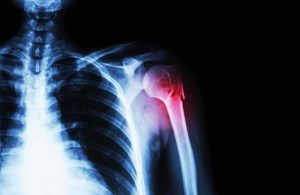Shoulder Dislocation
 A ball and socket joint, the shoulder joint has the most mobility of any other joint in the human body. While mobility has many advantages, mobility also makes the shoulder joint one of the joints most susceptible to injury. Doctors often see cases of shoulder dislocations and shoulder subluxations in patients, making shoulder dislocations a very common shoulder injury. Shoulder dislocations typically occur from trauma or sport injuries.
A ball and socket joint, the shoulder joint has the most mobility of any other joint in the human body. While mobility has many advantages, mobility also makes the shoulder joint one of the joints most susceptible to injury. Doctors often see cases of shoulder dislocations and shoulder subluxations in patients, making shoulder dislocations a very common shoulder injury. Shoulder dislocations typically occur from trauma or sport injuries.
In a dislocated shoulder, the humeral head completely separates from the glenoid cavity, or shoulder socket. During a partial dislocation, the head of the humerus only partially dislocates from the socket. Doctors may refer to partial dislocations using the term subluxation.
Symptoms of a Dislocated Shoulder
Both complete shoulder dislocations and shoulder subluxations cause pain and instability within the joint. During a shoulder dislocation, ligaments and tendons may tear or nerve damage may occur. A shoulder can dislocate in three directions: forward, backward, or downward. Common symptoms of shoulder dislocations include:
- Bruising
- Weakness
- Numbness
- Swelling
- Deformity
How doctors diagnose a dislocated shoulder
To diagnose a dislocated shoulder, doctors perform a physical examination followed by diagnostic testing. Typically doctors only need an X-Ray to confirm a shoulder dislocation but may also require an MRI if they suspect nerve, ligament, or tendon damage.
Treating a dislocated shoulder
Initially the doctor tries conservative treatment. The treating shoulder physician tries to guide the head of the humerus back into the glenoid cavity. If ligament or tendon tears accompany the dislocation, the doctor performs surgery.
Surgeons can perform shoulder dislocation surgery arthroscopically. An arthroscopic surgery means that the surgery get performed inserting tools into small portals. One portal has a camera inserted so the surgeon can see the inside of the surgical area while performing the surgery through the remaining portals. The amount of portals varies depending on the surgery. The benefits of arthroscopic surgery compared to open surgery include smaller incisions, lower infection rates, and faster healing times. During surgery, the surgeon tightens or repairs any torn tendons, ligaments, or cartilage. All of these structures work in conjunction to hold the shoulder joint together in  place.
place.
Recovering from a dislocated shoulder
Following surgical intervention for a dislocated shoulder, patients should remain in a sling to reduce movement for 4 to 6 weeks. Once the patient removes the sling, the treating physician prescribes a physical therapy protocol to strengthen the muscles surrounding the joint and restore range of motion.
To view a list of all insurances that AOA Orthopedic Specialists accept, click HERE. To schedule an appointment online, click HERE.
EXPERIENCING shoulder pain CALL 817-375-5200 TO SCHEDULE AN APPOINTMENT WITH AN AOA ORTHOPEDIC SPECIALIST TODAY!


